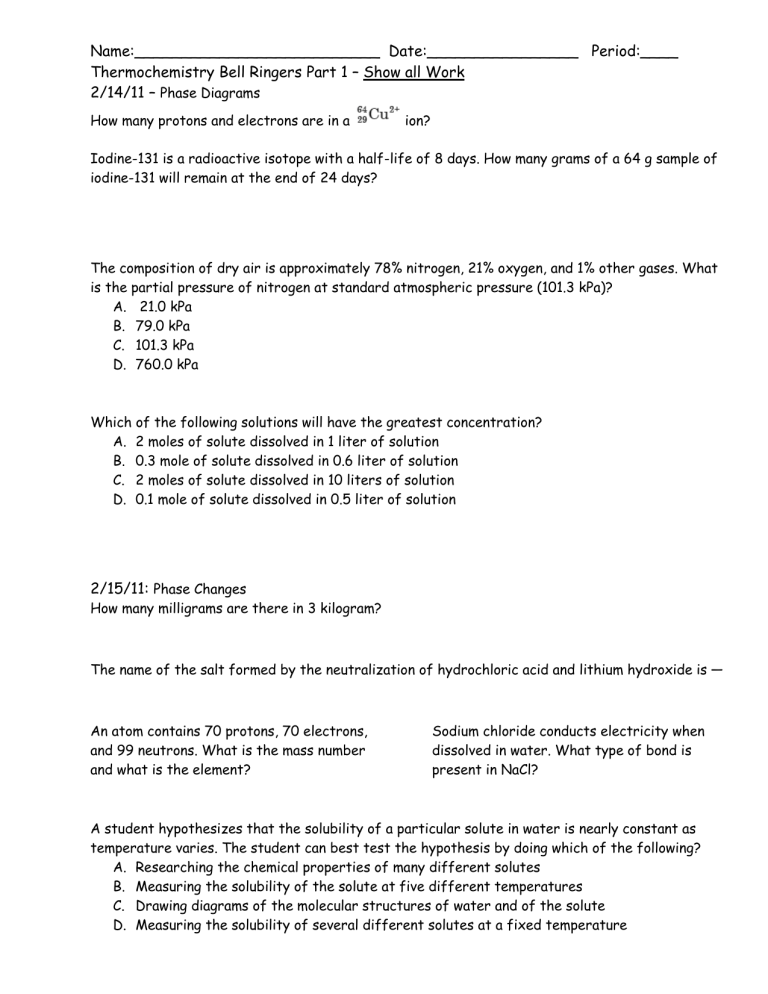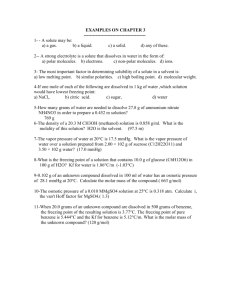Name:__________________________ Date:________________ Period:____

Name:__________________________ Date:________________ Period:____
Thermochemistry Bell Ringers Part 1 – Show all Work
2/14/11 –
Phase Diagrams
How many protons and electrons are in a ion?
Iodine-131 is a radioactive isotope with a half-life of 8 days. How many grams of a 64 g sample of iodine-131 will remain at the end of 24 days?
The composition of dry air is approximately 78% nitrogen, 21% oxygen, and 1% other gases. What is the partial pressure of nitrogen at standard atmospheric pressure (101.3 kPa)?
A.
21.0 kPa
B.
79.0 kPa
C.
101.3 kPa
D.
760.0 kPa
Which of the following solutions will have the greatest concentration?
A.
2 moles of solute dissolved in 1 liter of solution
B.
0.3 mole of solute dissolved in 0.6 liter of solution
C.
2 moles of solute dissolved in 10 liters of solution
D.
0.1 mole of solute dissolved in 0.5 liter of solution
2/15/11:
Phase Changes
How many milligrams are there in 3 kilogram?
The name of the salt formed by the neutralization of hydrochloric acid and lithium hydroxide is —
An atom contains 70 protons, 70 electrons, and 99 neutrons. What is the mass number and what is the element?
Sodium chloride conducts electricity when dissolved in water. What type of bond is present in NaCl?
A student hypothesizes that the solubility of a particular solute in water is nearly constant as temperature varies. The student can best test the hypothesis by doing which of the following?
A.
Researching the chemical properties of many different solutes
B.
Measuring the solubility of the solute at five different temperatures
C.
Drawing diagrams of the molecular structures of water and of the solute
D.
Measuring the solubility of several different solutes at a fixed temperature
2/16/11:
Specific Heat Introduction R = 0.821 atm L/mol K
A balloon is filled with 3.8 L of helium gas at STP. Approximately how many moles of helium are contained in the balloon?
A gas has a volume of 100.0 mL at a pressure of 600.0 mm Hg. If the temperature is held constant, what is the volume of the gas at a pressure of 800.0 mm Hg?
A.
33.33 mL
B.
66.67 mL
C.
75.00 mL
D.
133.0 mL
2/17/11 Heats of Fusion, Vaporization, Reactions
A sample of a gas is in a cylinder as shown. If the temperature is kept constant and the piston moves down to decrease the volume, the pressure increases because the gas particles —
A.
expand
B.
lose velocity within the container
C.
become smaller
D.
collide more frequently with the container
Which of the following is a solid/solid solution?
A.
An alloy of gold and copper
B.
A mixture of argon and krypton
C.
A strongly electrolytic acid
D.
A neutralized base
2/18/11 Quiz - Turn in Bellringers
Examine the graph of the temperature of a compound versus heat added to the compound. Which of the following most likely happens as the compound is heated from point x to point y?
A.
The mass of the compound is increasing.
B.
The molecules of the compound lose potential energy.
C.
The phase of the compound changes.
D.
The molecules of the compound are breaking apart into atoms.




